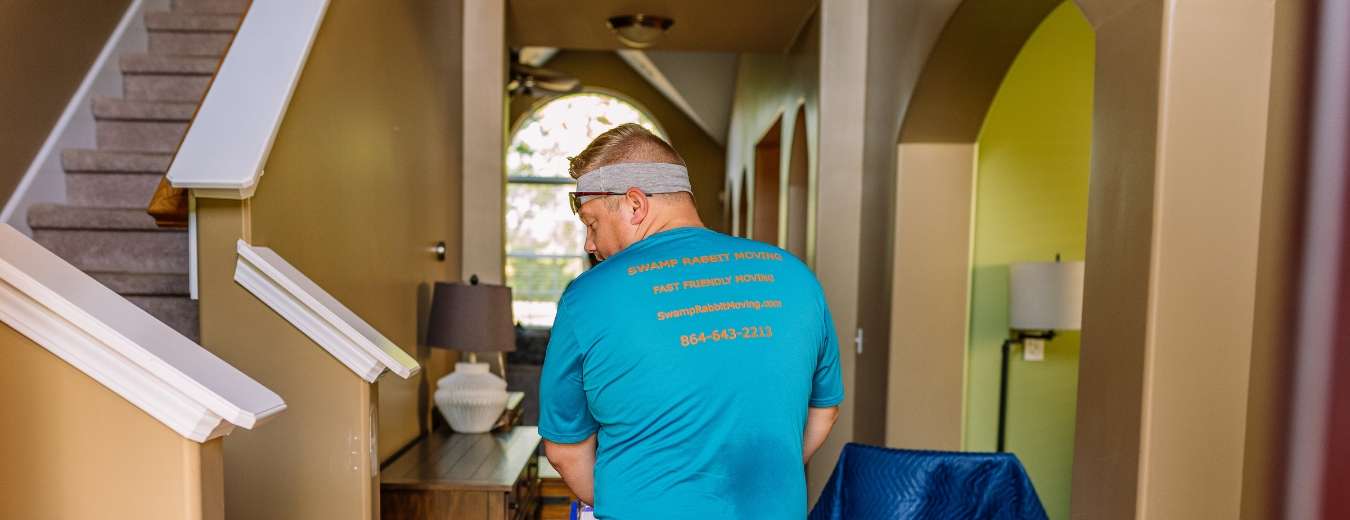Moving can be a daunting task, especially when faced with the challenge of fitting your beloved furniture through narrow hallways and doors. But worry not, as Swamp Rabbit Moving & Storage, Greenville, South Carolina's full-service moving company, is here to guide you through every twist and turn. This guide is tailored to help you master the art of moving in tight spaces, ensuring a smoother transition to your new home.
Welcome to the Challenge: Mastering the Maze of Narrow Spaces
Moving large items through narrow spaces is a common obstacle many face during relocation. The fear of damaging your furniture or the property itself can add unnecessary stress to your moving day. However, with the right techniques and a bit of planning, this challenge can be easily overcome. At Swamp Rabbit Moving & Storage, we specialize in navigating these tight spots, bringing years of expertise and the right equipment to ensure your belongings reach their destination unscathed.
Understanding the Terrain: Narrow Hallways and Doors
Narrow hallways and doors are more than just physical barriers; they represent the need for strategic planning and careful maneuvering. Typically, any passageway with a width less than 36 inches is considered narrow, requiring special attention during a move. The struggle often involves more than just bulky furniture; architectural features such as tight corners and low ceilings can complicate the moving process further.
Common Problems Encountered:
- Scratches or dents in furniture and walls
- Difficulty in maneuvering large pieces
- Increased risk of injury without the proper techniques
Pre-Move Preparations: Setting the Stage for Success
Thorough preparation is crucial for a successful move, especially when navigating narrow spaces. Start by measuring your furniture and the doorways of both your current and new homes. A detailed floor plan can also help in strategizing the move. Additionally, decluttering is an effective way to minimize the items you need to maneuver, simplifying the moving process.
Key Steps for Pre-Move Preparations:
- Measure furniture and doorways
- Create a floor plan
- Declutter and donate unnecessary items
The Right Tools for the Job: Essential Equipment
Equipping yourself with the right tools can significantly ease the challenge of moving through narrow passageways. Tools such as furniture sliders, moving dollies, and shoulder dollies not only safeguard your items but also help prevent physical strain.
- Furniture Sliders: Ideal for sliding heavy items across the floor without causing damage.
- Moving Dollies: Useful for transporting heavy and bulky items with ease.
- Shoulder Dolly: A two-person lifting system that redistributes the weight of the item, making it easier to carry.
Strategy Session: Planning Your Approach
An essential aspect of navigating narrow hallways and doors is developing a thoughtful strategy before the moving day arrives. The sequence in which you move items, the methods used for angling furniture, and the decision to disassemble pieces all play pivotal roles in a successful move.
Deciding the Order of Moving Items
Begin with a clear plan on which items should be moved first. Typically, it's wise to start with the largest and most cumbersome pieces. This not only clears substantial room for maneuvering later but also tackles the most challenging tasks while the movers' energy levels are high.
Techniques for Tilting and Angling Furniture
Sometimes, the secret to getting a bulky item through a tight spot is all in the angle. Practice angling furniture in different ways, looking for the narrowest profile to fit through doorways or hallways. In some cases, flipping an item on its side or end can provide the few extra inches needed for clearance.
When to Disassemble Furniture and How to Do It Safely
Disassembling furniture can make a significant difference in tight spaces. However, it's essential to:
- Mark each piece and its corresponding hardware to ensure easy reassembly
- Use the right tools to avoid damaging the items
- Keep all hardware in a labeled bag for each piece of furniture
Teamwork Makes the Dream Work: Assisting Your Move
Effective communication and coordination between all involved is vital to navigating tight spaces safely and efficiently. Providing professional packing and unpacking service, proper techniques for lifting and moving heavy objects are not just about muscles; They involve understanding best practices for weight distribution and movement.
The Importance of Clear Communication and Coordination Among Movers
Before lifting a single item, ensure that everyone knows their role and the plan of action. Communication is crucial, especially when maneuvering through tight spaces where visibility may be limited.
How to Safely Lift and Carry Heavy Items
- Always lift with your legs, not your back, to prevent injury.
- Use lifting straps or a shoulder dolly for heavier items to distribute weight more evenly.
- Work slowly and deliberately, as rushing can lead to accidents or damages.
The Role of Professional Movers
Professional movers, like those from Swamp Rabbit Moving & Storage, bring experience and expertise to the table. They are trained in the safest and most efficient methods for moving items through challenging spaces, making them invaluable for a stress-free move.
Our team not only understands the intricacies of moving in tight spaces but also prioritizes the safety of your belongings and everyone involved in the move.
Navigating the Maze: Step-by-Step Guide Through Narrow Spaces
Successfully moving through narrow hallways and doors requires more than just muscle and determination-it's about technique and precision. Here's a detailed guide to help you navigate those tight corners and low clearances with ease.
- Prepare the Path: Before lifting anything, ensure the path is clear of any obstacles. Remove rugs, door mats, and any loose items that could cause trips or slips. If possible, remove doors from their hinges to gain extra inches of clearance.
- Protect Surfaces and Furniture: Wrap sharp corners and fragile parts of furniture with protective padding. Use door frame protectors, if available, to avoid scratching or denting the woodwork.
- Guidance and Spotters: Have a person guide the mover carrying the item to offer immediate feedback on angles and clearance. Spotters can also help protect the home and the item from accidental damage.
- Slow and Steady Wins the Race: Move slowly and deliberately. Quick movements can lead to mistakes. If an item doesn't fit, pause and reassess rather than forcing it through.
- Alternate Techniques: If a piece of furniture refuses to fit despite angling and maneuvering, consider removing it from its location by using windows or other openings. This method should be a last resort and performed with utmost care.
When to Call in the Experts: Professional Help for Tight Spots
There are times when DIY moving strategies hit a wall—literally or figuratively. This is when professional movers become invaluable. Here are situations where calling in experts like Swamp Rabbit Moving & Storage can save the day:
- Extremely Heavy or Bulky Items: Professional movers are trained to handle heavy loads safely and have the tools to make it happen.
- High-Value Items: Antiques, pianos, and artwork may require specialized moving techniques to prevent damage.
- Limited Time or Assistance: When you're on a tight schedule or don't have enough help, professional movers can efficiently tackle the job.
Safeguarding Your Belongings: Protection and Care
The key to a successful move through tight spaces lies not only in the skills of navigating but also in protecting your belongings and property from damage.
- Padding and Protection: Use furniture blankets, foam padding, or bubble wrap to cover items. Pay special attention to edges and corners.
- Floor Protectors: Consider using temporary floor coverings to protect hardwood or tiled floors from scratches or dents.
- Insurance and Liability: Understand what is covered by your moving company’s insurance policy. Swamp Rabbit Moving & Storage offers comprehensive coverage options to give you peace of mind.
Real-Life Success Stories: Narrow Escapes Made Easy
Hearing about successful moves through challenging spaces can be incredibly reassuring. Here are a couple of anecdotes from Swamp Rabbit Moving & Storage customers who faced the daunting task of navigating narrow hallways and doors:
- The Grand Piano Miracle: A family heirloom, a grand piano, needed to make its way through an antique home's narrow passages. With strategic maneuvering and custom tools, the team successfully relocated the piano without a scratch.
- The Sleeper Couch Situation: A bulky sleeper couch trapped in a basement posed a significant challenge. By carefully disassembling the couch and employing team lifting techniques, the couch saw daylight once more, damage-free.
Wrapping Up: Your Pathway to a Stress-Free Move
Circumventing the labyrinth of tight hallways and doorways during a move doesn't have to spell disaster. With the strategies and insights shared in this guide, you're well on your way to mastering the art of moving in constricted spaces. Remember, preparation, the right tools, and a solid plan are your best allies in ensuring your belongings make it through unscathed.
Whether you're moving a cherished family heirloom or reconfiguring your living space to welcome your newest acquisitions, we stand ready to make your transition as smooth and worry-free as possible. Our commitment to excellence and customer satisfaction ensures that your moving experience is nothing short of exceptional.
FAQ: Quick Tips and Tricks for Navigating Narrow Spaces
To round off our comprehensive guide, here are some quick answers to common questions about moving in tight spaces:
Q1: What if my furniture doesn’t fit through the door at all? A1: If a piece of furniture appears impossible to fit through a doorway, consider alternate exits such as windows or, as a last resort, disassembling the item further. Professional movers can provide advice and assistance in these situations.
Q2: How do I protect my fragile items during the move? A2: Use bubble wrap, packing paper, and sturdy boxes. Label boxes as "FRAGILE" and inform your movers or helpers about the items’ sensitivity.
Q3: Can Swamp Rabbit Moving & Storage help with moves outside of Greenville, SC? A3: Yes, we provide moving services beyond Greenville. Contact us with your specifics, and we’ll assist you with your moving needs, no matter the location.
Q4: How far in advance should I book moving services? A4: It’s recommended to book as early as possible, especially during peak seasons. A lead time of 4-6 weeks is ideal for ensuring your preferred dates are available.
Your home's narrow hallways and doors shouldn't be a barrier to a successful move. With proper planning, the right approach, and a touch of patience, navigating these spaces becomes an achievable task. And remember, whenever you're in doubt or need assistance, Swamp Rabbit Moving & Storage is just a call away, ready to leap into action and smooth out the bumps in your moving road.
Thank you for joining us on this detailed journey through narrow spaces. Whether you're gearing up for a move or just planning ahead, we hope this guide serves as a valuable resource for making your transition as seamless and stress-free as possible. Safe travels on your moving adventure, and if you need any help along the way, call our Greenville SC movers at 864-643-2213 for a free quote!






